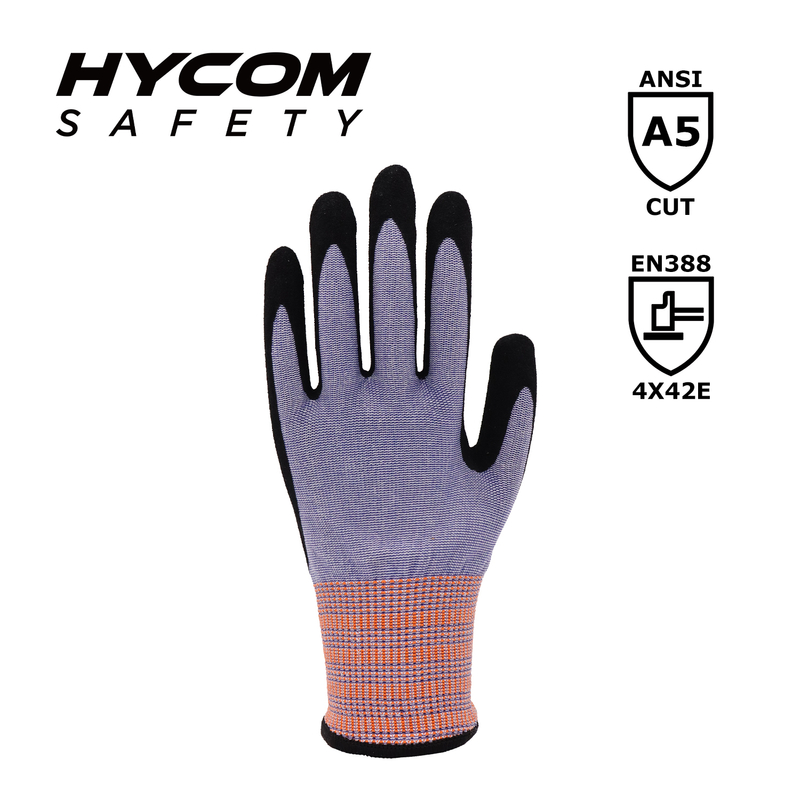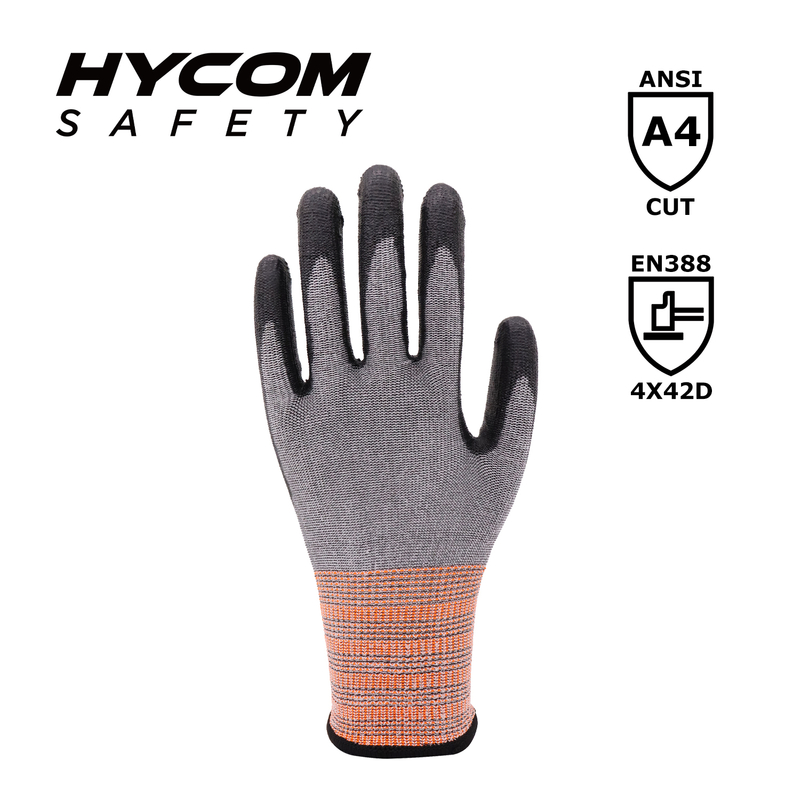Views: 0 Author: Site Editor Publish Time: 2025-10-20 Origin: Site







Have you ever wondered how to protect your hands from workplace hazards? Resistant gloves are essential tools that provide safety in various industries.
In this article, we will explore what resistant gloves are, their purpose, and why they are crucial for preventing hand injuries. You’ll learn about the different types of resistant gloves and their protective features.
Resistant gloves are specialized protective gear designed to safeguard hands from various hazards. They are made from durable materials that provide a barrier against cuts, abrasions, and other injuries. These gloves are essential in many work environments, including construction, manufacturing, and food processing.
The primary purpose of resistant gloves is to protect workers' hands during tasks that involve potential risks. They serve as a first line of defense against injuries, ensuring safety while maintaining functionality.
Different industries rely on resistant gloves for safety. Here’s a quick look at some key sectors:
● Construction: Protects against cuts and abrasions from tools and materials.
● Manufacturing: Shields hands from sharp objects and machinery.
● Food Service: Prevents contamination and protects against cuts.
● Healthcare: Offers barrier protection from biohazards.
Resistant gloves are vital for several reasons. They help prevent workplace injuries, which can lead to lost time and increased costs. Wearing these gloves can significantly reduce the risk of hand injuries, ensuring a safer work environment for everyone.
Here are some common hazards that resistant gloves can help mitigate:
● Cuts and Lacerations: Sharp tools and materials can easily cause injuries.
● Chemical Exposure: Certain gloves are designed to resist harmful substances.
● Heat and Burns: Some gloves provide thermal protection in high-temperature environments.
● Punctures: Protects against sharp objects that can penetrate the skin.
Did you know that hand injuries are among the most common workplace injuries? Here are some alarming statistics:
● Approximately 70% of hand injuries could be prevented with proper glove use.
● The U.S. Bureau of Labor Statistics reports over 1 million hand injuries each year.
● Hand injuries account for about 20% of all workplace injuries.
These numbers highlight the importance of wearing resistant gloves. They are not just a safety measure; they are essential for protecting workers and promoting a culture of safety in the workplace.

When choosing resistant gloves, protection levels are crucial. Different gloves offer varying degrees of safety.
● Cut Resistance: Measured by ANSI standards A2 to A7, indicating how well gloves can withstand cuts.
● Detailed Breakdown of ANSI/ISEA 105 Standard: This standard categorizes gloves based on their performance against cuts, punctures, and abrasions.
● EN388 Ratings: For instance, a rating like 4X42B indicates specific levels of protection against cuts, abrasions, and punctures.
Rating | Cut Resistance | Abrasion Resistance | Puncture Resistance |
4X42B | Level 4 | Level 4 | Level 2 |
4X42C | Level 4 | Level 4 | Level 3 |
● Overview of Abrasion and Puncture Resistance Ratings:
○ ANSI ABR A4: Indicates high abrasion resistance.
○ ANSI Level 4: Reflects strong puncture resistance.
Some gloves come with added features for specific tasks:
● Arc Flash Protection: Important for electrical work, ensuring safety from electrical hazards.
● Water Resistance: Keeps hands dry in wet conditions.
● Oil Retardancy: Protects against oils and greases.
The materials used in resistant gloves significantly impact their performance.
● High-Performance Fibers:
○ HPPE: High-performance polyethylene offers excellent cut resistance.
○ Para-Aramid: Known for its strength and heat resistance.
○ Tungsten-Blended Yarns: Provides exceptional durability.
● Eco-Friendly Materials:
○ Gloves made with 20% recycled yarns and biodegradable options are becoming popular.
Different coatings can improve grip and durability:
● Polyurethane: Offers a lightweight feel and good grip.
● Nitrile (foam and sandy): Provides excellent oil resistance and grip.
● Neoprene: Known for its flexibility and resistance to chemicals.
● TPR (Thermoplastic Rubber): Adds impact protection.
Comfort is key when wearing resistant gloves, especially for long periods.
● Ergonomic Designs: These gloves are shaped to fit the natural contours of hands.
● Breathable Liners: Help keep hands cool and dry during use.
● Certification for Skin-Friendliness: Many gloves undergo dermatological testing to ensure they are safe for skin contact.
● Ultra-Light Liners: Available in 7G, 13G, or 18G, these liners provide a snug fit.
● Flexible Coatings: Allow for better movement and control.
● Importance of Fine Motor Skills: Maintaining dexterity is crucial for tasks requiring precision.
Many resistant gloves come with additional features to improve usability.
● Touchscreen Compatibility: Allows users to operate devices without removing gloves.
● FDA-Approved Anti-Microbial Properties: Essential for food-grade applications, ensuring hygiene.
● Secure Fit Options: Features like hook-and-loop closures help ensure a snug fit.
These features make resistant gloves versatile and suitable for various tasks, enhancing safety and functionality in the workplace.
Resistant gloves are increasingly designed with sustainability in mind. Here’s how they contribute to a greener future:
● Use of Recycled Materials: Many manufacturers incorporate recycled fibers in their gloves, reducing waste.
● Certifications: Look for certifications like the Global Recycled Standard. This ensures materials are sourced responsibly and meet environmental criteria.
Certifications play a vital role in promoting eco-friendly practices. Here are some key certifications to consider:
Certification | Description |
Global Recycled Standard | Ensures recycled materials are used responsibly. |
OEKO-TEX® Standard 100 | Guarantees textiles are free from harmful substances. |
Manufacturers are also focused on reducing harmful chemicals in glove production. For example, the elimination of DMF (Dimethylformamide) helps protect both workers and the environment.
Durability is a crucial aspect of resistant gloves. Here’s what makes them long-lasting:
● Reinforcement in High-Wear Areas: Key areas like palms and thumb saddles often receive extra reinforcement. This helps prevent wear and tear during heavy use.
Reinforced areas can significantly extend the life of gloves. For instance, gloves designed for construction work often feature additional stitching and stronger materials in these zones.
Many resistant gloves are machine-washable, making maintenance straightforward. This feature allows users to keep gloves clean without compromising their integrity.
To get the most out of resistant gloves, follow these maintenance tips:
● Regular Cleaning: Wash gloves according to manufacturer instructions to remove dirt and grime.
● Proper Storage: Store gloves in a cool, dry place to prevent deterioration.
● Avoid Excessive Heat: Keep gloves away from direct sunlight or heat sources, which can weaken materials.
By focusing on eco-friendly attributes and durability, resistant gloves not only protect hands but also contribute to a sustainable future.

The resistant glove market is vibrant and competitive. Let’s dive into the key players and what sets them apart.
Some of the leading brands include:
● Ansell: Known for a wide range of safety gloves.
● Honeywell: Offers innovative solutions for various industries.
● Showa: Focuses on eco-friendly materials and technologies.
● MCR Safety: Provides gloves tailored for specific applications.
Brands distinguish themselves through:
● Material Quality: The choice of fibers and coatings impacts durability and comfort.
● Innovative Designs: Ergonomic features and user-friendly designs enhance usability.
● Price Points: Different brands cater to various budgets, from economical to premium options.
Here’s a snapshot of some competitive features:
Brand | Key Features | Innovations |
Ansell | High cut resistance, ergonomic fit | Proprietary cut-resistant technology |
Honeywell | Chemical resistance, touchscreen compatibility | Grip-enhancing coatings |
Showa | Eco-friendly materials, customizable options | Sustainable production methods |
MCR Safety | Wide range of sizes, specialized designs | Advanced grip technologies |
Technology plays a significant role in the development of resistant gloves. Here’s what’s trending:
● Proprietary Cut-Resistant Technologies: Brands like Ansell utilize unique blends of fibers to enhance cut resistance. These proprietary technologies often outperform standard options.
Technology Type | Description | Performance Level |
Proprietary Technology | Advanced blends for superior cut protection | Higher cut resistance ratings |
Standard Options | Traditional materials with basic cut resistance | Adequate for general tasks |
Grip is crucial for safety and efficiency. Here are some popular innovations:
● Textured Coatings: Many gloves now feature textured surfaces to improve grip, especially in wet or oily conditions.
● Foam Nitrile Coatings: These provide excellent grip while maintaining flexibility.
The market also offers specialized resistant gloves tailored for specific needs.
● Cold-Weather Resistant Gloves: Designed to keep hands warm while providing protection against cuts and abrasions.
● Anti-Static Gloves: Essential for electronics manufacturing, these gloves prevent static electricity buildup.
● Task-Specific Gloves: Gloves tailored for industries like food processing or industrial maintenance ensure safety and compliance.
Type of Glove | Key Features | Ideal Use Cases |
Cold-Weather Resistant | Insulation, grip, cut resistance | Outdoor work in cold climates |
Anti-Static | Prevents static discharge | Electronics assembly |
Food Processing | Food-safe materials, easy to clean | Food handling and preparation |
With such a diverse range of options, the resistant glove market continues to evolve, meeting the needs of various industries and tasks.
Selecting the right resistant glove is crucial for safety and efficiency. Here are some key factors to keep in mind.
1. Assessing Task Hazards: Start by identifying the specific hazards associated with your task. Are you dealing with sharp objects, chemicals, or extreme temperatures? Knowing this helps narrow down your options.
2. Glove Specifications: Look for gloves that meet the required specifications for your tasks. Key features to consider include:
a. Cut Resistance: Measured by ANSI levels, higher levels indicate better protection against cuts.
b. Chemical Resistance: Check if the gloves are suitable for the chemicals you might encounter.
3. Importance of Matching ANSI Levels to Task Requirements: The American National Standards Institute (ANSI) provides levels for cut resistance. It’s essential to match these levels to your specific needs. For example:
ANSI Level | Cut Resistance Rating | Ideal Use Cases |
A1 | Low | General handling |
A5 | High | Glass handling, metal work |
A9 | Very High | Heavy-duty applications |
4. Importance of Comfort and Fit: A glove that fits well enhances dexterity and reduces fatigue. Look for features like adjustable cuffs and flexible materials. Remember, if it’s uncomfortable, you’re less likely to wear it properly.
Understanding safety standards is vital when choosing resistant gloves. Here’s what you need to know.
● EN ISO 21420:2020: This European standard covers general requirements for protective gloves, ensuring they provide adequate protection.
● REACH Compliance: This regulation addresses the safe use of chemicals in manufacturing, ensuring gloves are free from harmful substances.
Here’s a quick overview of key regulations:
Regulation | Description |
EN ISO 21420:2020 | Sets safety and performance criteria for gloves. |
REACH | Ensures chemical safety in glove production. |
Compliance with these standards is essential for workplace safety. Gloves that meet recognized standards ensure they provide the necessary protection. Non-compliant gloves may expose workers to unnecessary risks, leading to injuries or health issues.
By considering these factors and understanding compliance, you can select the right resistant glove for your needs.
Resistant gloves play a vital role in workplace safety. They protect against cuts, chemicals, and other hazards.
Key points include understanding task hazards, matching ANSI levels, and ensuring comfort. Compliance with standards like EN ISO 21420:2020 is crucial for safety.
When selecting gloves, prioritize safety and comfort. Always choose gloves that fit well and meet your specific needs. Your safety depends on it!
A: There are cut-resistant, chemical-resistant, cold-weather, and anti-static gloves, each designed for specific hazards.
A: Clean them according to the manufacturer's instructions, avoid harsh chemicals, and inspect regularly for damage.
A: Yes, but ensure they are made from food-safe materials and comply with relevant safety standards.
A: Many resistant gloves are designed for wet conditions, but check the specifications for water resistance.
A: Look for certifications like EN ISO 21420:2020 and check for ANSI ratings.
A: They reduce environmental impact, often use sustainable materials, and can provide the same level of protection as traditional gloves.
